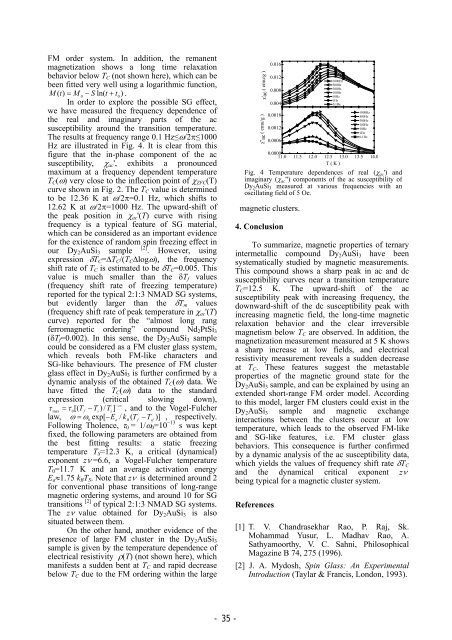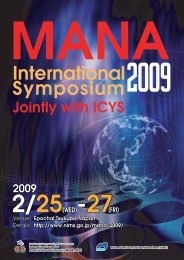物質・材料研究機 共用基盤部門 強磁場共用ステーション 2008 年度 ...
物質・材料研究機 共用基盤部門 強磁場共用ステーション 2008 年度 ...
物質・材料研究機 共用基盤部門 強磁場共用ステーション 2008 年度 ...
You also want an ePaper? Increase the reach of your titles
YUMPU automatically turns print PDFs into web optimized ePapers that Google loves.
FM order system. In addition, the remanent<br />
magnetization shows a long time relaxation<br />
behavior below T C (not shown here), which can be<br />
been fitted very well using a logarithmic function,<br />
M t)<br />
= M − S ln( t + ) .<br />
( t<br />
0 0<br />
In order to explore the possible SG effect,<br />
we have measured the frequency dependence of<br />
the real and imaginary parts of the ac<br />
susceptibility around the transition temperature.<br />
The results at frequency range 0.1 Hz≤ω/2π≤1000<br />
Hz are illustrated in Fig. 4. It is clear from this<br />
figure that the in-phase component of the ac<br />
susceptibility, χ ac ', exhibits a pronounced<br />
maximum at a frequency dependent temperature<br />
T C (ω) very close to the inflection point of χ ZFC (T)<br />
curve shown in Fig. 2. The T C value is determined<br />
to be 12.36 K at ω/2π=0.1 Hz, which shifts to<br />
12.62 K at ω/2π=1000 Hz. The upward-shift of<br />
the peak position in χ ac '(T) curve with rising<br />
frequency is a typical feature of SG material,<br />
which can be considered as an important evidence<br />
for the existence of random spin freezing effect in<br />
our Dy 2 AuSi 3 sample<br />
[2] . However, using<br />
expression δT C =ΔT C /(T C Δlogω) the frequency<br />
shift rate of TC is estimated to be δT C =0.005. This<br />
value is much smaller than the δT f values<br />
(frequency shift rate of freezing temperature)<br />
reported for the typical 2:1:3 NMAD SG systems,<br />
but evidently larger than the δT m values<br />
(frequency shift rate of peak temperature in χ ac '(T)<br />
curve) reported for the “almost long rang<br />
ferromagnetic ordering” compound Nd 2 PtSi 3<br />
(δT f =0.002). In this sense, the Dy 2 AuSi 3 sample<br />
could be considered as a FM cluster glass system,<br />
which reveals both FM-like characters and<br />
SG-like behaviours. The presence of FM cluster<br />
glass effect in Dy 2 AuSi 3 is further confirmed by a<br />
dynamic analysis of the obtained T C (ω) data. We<br />
have fitted the T C (ω) data to the standard<br />
expression (critical slowing down),<br />
− zν<br />
τ = τ [( T − T ) / T ]<br />
max 0 f s s<br />
, and to the Vogel-Fulcher<br />
law, ω = ω 0<br />
exp[ −E a<br />
/ k<br />
B<br />
( T<br />
f<br />
−Tvf<br />
)] , respectively.<br />
Following Tholence, τ 0 = 1/ω 0 =10<br />
−13 s was kept<br />
fixed, the following parameters are obtained from<br />
the best fitting results: a static freezing<br />
temperature T S =12.3 K, a critical (dynamical)<br />
exponent zν =6.6, a Vogel-Fulcher temperature<br />
T 0 =11.7 K and an average activation energy<br />
E a ≈1.75 k B<br />
TB<br />
S. Note that zν is determined around 2<br />
for conventional phase transitions of long-range<br />
magnetic ordering systems, and around 10 for SG<br />
[2]<br />
transitions of typical 2:1:3 NMAD SG systems.<br />
The zν value obtained for Dy2AuSi 3 is also<br />
situated between them.<br />
On the other hand, another evidence of the<br />
presence of large FM cluster in the Dy 2 AuSi 3<br />
sample is given by the temperature dependence of<br />
electrical resistivity ρ(T) (not shown here), which<br />
manifests a sudden bent at T C and rapid decrease<br />
below T C due to the FM ordering within the large<br />
χ'ac ( emu/g )<br />
χ"ac ( emu/g )<br />
0.016<br />
0.012<br />
0.008<br />
0.004<br />
magnetic clusters.<br />
4. Conclusion<br />
To summarize, magnetic properties of ternary<br />
intermetallic compound Dy2AuSi 3 have been<br />
systematically studied by magnetic measurements.<br />
This compound shows a sharp peak in ac and dc<br />
susceptibility curves near a transition temperature<br />
T C =12.5 K. The upward-shift of the ac<br />
susceptibility peak with increasing frequency, the<br />
downward-shift of the dc susceptibility peak with<br />
increasing magnetic field, the long-time magnetic<br />
relaxation behavior and the clear irreversible<br />
magnetism below T C are observed. In addition, the<br />
magnetization measurement measured at 5 K shows<br />
a sharp increase at low fields, and electrical<br />
resistivity measurement reveals a sudden decrease<br />
at T C . These features suggest the metastable<br />
properties of the magnetic ground state for the<br />
Dy 2 AuSi 3 sample, and can be explained by using an<br />
extended short-range FM order model. According<br />
to this model, larger FM clusters could exist in the<br />
Dy 2 AuSi 3 sample and magnetic exchange<br />
interactions between the clusters occur at low<br />
temperature, which leads to the observed FM-like<br />
and SG-like features, i.e. FM cluster glass<br />
behaviors. This consequence is further confirmed<br />
by a dynamic analysis of the ac susceptibility data,<br />
which yields the values of frequency shift rate δT C<br />
and the dynamical critical exponent zν<br />
being typical for a magnetic cluster system.<br />
References<br />
0.0018<br />
0.0012<br />
0.0006<br />
0.0000<br />
11.0 11.5 12.0 12.5 13.0 13.5 14.0<br />
[1] T . V. Chandrasekhar Rao, P. Raj, Sk.<br />
Mohammad Yusur, L. Madhav Rao, A.<br />
Sathyamoorthy, V. C. Sahni, Philosophical<br />
Magazine B 74, 275 (1996).<br />
[2] J. A. Mydosh, Spin Glass: An Experimental<br />
Introduction (Taylar & Francis, London, 1993).<br />
<br />
<br />
1000Hz<br />
500Hz<br />
300Hz<br />
100Hz<br />
10Hz<br />
1Hz<br />
0.1Hz<br />
1000Hz<br />
500Hz<br />
300Hz<br />
100Hz<br />
10Hz<br />
1Hz<br />
0.1Hz<br />
T ( K )<br />
Fig. 4 Temperature dependences of real (χ ac ') and<br />
imaginary (χ ac ") components of the ac susceptibility of<br />
Dy 2 AuSi 3 measured at various frequencies with an<br />
oscillating field of 5 Oe.<br />
- 35 -















